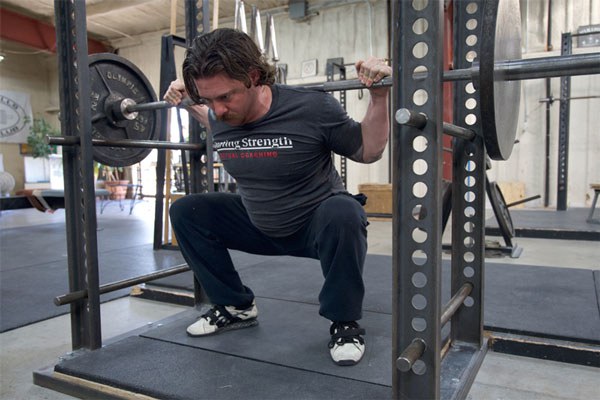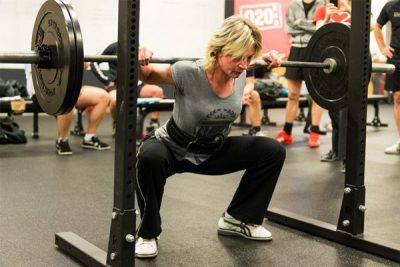
A long time ago, barbells were
thought to be dangerous. This was a common belief among doctors, your
grandparents, gym teachers, real estate salesmen, guys who maintained
swimming pools, the manager at the YMCA, and other people who did not
train with barbells. It was apparently based on the fact that
barbells can fall on you, a characteristic common to all physical
objects if handled improperly. The truth of the matter is that
barbell training gyms – when staffed with people who keep their
heads out of their asses – are among the safest places on earth.
Next to single-floor libraries without stairs to fall down, barbell
gyms are awfully damned safe places.
Now,
it is not completely impossible to get hurt in a barbell gym, but you
have to make serious errors that involve just not paying any
attention to what you are doing. If you pull the 45-pound plate off
of the bar and there’s a 2.5 on the bar outside of it that you don’t
see, it can fall and hit your foot. If you rerack the bar and miss
one of the hooks, the bar will fall on you – if this happens on the
bench press, it can kill you. If you take a thumbless grip on the
bench press, it can fall on your chest or throat and kill you. If you
take a very wide sumo stance on the deadlift and your feet slip out
during the pull, the plates can chop off your toes when you set the
bar down (this is one very good reason to use a conventional stance).
If you leave plates lying on the platform where you are doing your
cleans, spectacular accidents can and do occur.
The
use of the power rack increases safety in the gym to the point that
if you get hurt under the bar, it’s your own damn fault. Squats,
presses, bench presses, or any lift where you are actually underneath
the bar can be performed in the rack while being protected by the
safety pins set at the correct height. Snatches, cleans, and jerks
are performed with bumper plates, and learning to drop the bar safely
is part of learning the lifts.
There is risk inherent in
performing limit attempts, as in a competition. Most lifters who
enter meets do not get injured, but some do, and this is the nature
of competitive sports – there is risk in testing your limits that
does not exist in training to expand those limits. But the bottom
line is that the barbell lifts are not dangerous – at all – if
performed correctly and consistently with some commonsense
preparations.
But
knee and elbow tendonitis are common complaints among gym members all
over the world, right? This is the fault of two different mechanisms,
1.) poor form on the barbell lifts, and 2.) the use of exercise
machines. Poor form under the bar places components of the kinetic
chain in positions of loading that are not compatible with their
normal anatomical function – knees, elbows, and shoulders do not
respond well to loading disproportionate to their position in the
kinetic chain, and tendons and ligaments get inflamed. Once inflamed,
they can stay that way quite a while, so good form is important.
Opinions vary on the definition of “good form,” but I have made
all these errors and figured them out, so if I were you I’d trust me
when I tell you how to do the basic barbell exercises.
Exercise
machines are a different problem, primarily because they isolate a
kinetic chain component in order to work a single muscle group
separately, an idea peculiar to bodybuilding and foreign to strength
training. They do this by making one or more of the joints in the
chain stationary to isolate the function of the flexor or extensor at
the joint. Leg curls, preacher curls, and the pec deck are examples
of machines that isolate muscle groups by fixing the position of a
normally mobile joint or joints.
For
example, in the press the bar moves into lockout overhead using elbow
extension, shoulder flexion, and scapular elevation, supported by all
the trunk muscles, the hips, and the legs. This distributes the
stress over the entire kinetic chain – from the floor to the hands
– and preventing the entrapment of any one of the structures. Some
of the muscle mass directly moves the load while the rest of it is
locked in isometric contraction to support the loaded body. In
contrast, a knee extension machine works the quads by placing all the
force on the quadriceps and patellar tendons, with no way to load any
of the stress onto the hips, low back, and ankles that would normally
share it.
And
don’t forget the higher reps for these assistance exercises. There
are few better ways to inflame a joint than to isolate it from its
buddies in the kinetic chain and do 5 sets of 10, the common
prescription for isolation machine work. The reason for this is that
you are chasing “the pump,” that wonderfully satisfying feeling a
blood-engorged muscle belly provides the lifter of light weights and
high reps – a feeling that has absolutely nothing to do with an
increase in strength.
Normal
human movement patterns always involve multiple joints and lots of
muscles, allowing heavy loads to be moved without isolating any one
joint. Squatting down and standing back up, picking something up from
the ground, pushing something overhead, pushing something away from
you, and pulling something toward you are normal human movement
patterns, none of which isolate anything, none of which produce
injuries when trained correctly, and all of which produce a marked
increase in strength by adding to the load each time they are
trained.
Simply
put, the multiple joints in a kinetic chain allow many points of
rotation within the movement, which prevents “focal stress” on
any one of them. Compound-joint exercises distribute the stress over
multiple structures and don’t cause connective tissue injuries, while
machine isolation-type exercises stress a limited number of joints
and produce un-moderated stress focused on single joints. If the
movement pattern is the entire loaded system instead of one of its
kinetic chain components, the whole movement gets strong and the
joints within it are buffered from isolation and focal stress.
Barbell
training – properly
conducted –
produces remarkably few injuries, and almost all of them due to you
fucking up. Since we are gradually increasing the loads on normal
human movement patterns you are already designed to perform, strength
accumulates as the loads increase, making injuries even less likely
to occur over time. In contrast, machine-based exercise seems almost
designed
to irritate joints, tendons, and ligaments if you use enough weight
to challenge existing levels of strength. If you have to use machines
(and I don’t know why you should) keep the weights light, and just
enjoy your “pump.”








